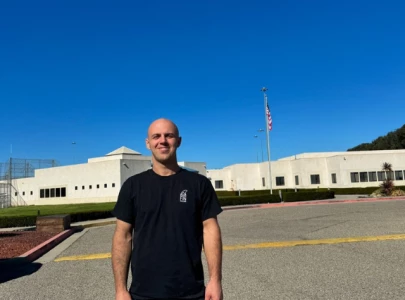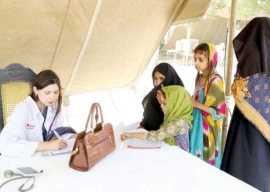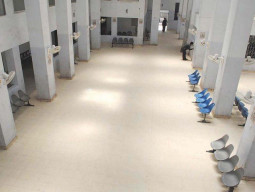
Nearby his mother, 53-year-old Hurmi, cannot walk at all, and is forced to crawl on the ground. This is not just the story of one house or one family. This is the story of each and every household in village Sammon Rind in tehsil Chachro, Tharparkar, about 480 km from Karachi. Almost all of the 3,000-plus people here walk with their spines bent, unable to stand up straight. The reason for their suffering is the very substance that sustains life itself: water. And in this village, every drop is tainted.
A timeline of Ramesh’s life is typical of almost all residents of this area. The highly contaminated water first affects the teeth, which start becoming deformed around the age of five to seven. Between 12 to 15 years of age, bone deformities start setting in. Coupled with the harsh and hot desert climate and chronic malnutrition, even adolescents start acquiring a shriveled appearance, mimicking old age. By the time they are 25-year-old or above, almost all of them walk with their spines bent. Water, the source of life, has ended up crippling not just their bodies but their dignity and their chance at a normal life. And no one seems to care.
Former Secretary General of the United Nations Kofi Annan once said that contaminated water jeopardises both the physical and social health of people, and is therefore “an affront to human dignity”. The reality of this remote part of Pakistan is that no head is held up high, literally.
Almost poison
Seeing the standards the World Health Organisation (WHO) has set for water safe for human consumption, one is forced to wonder how people in villages like Samoon Rind and Mau Akheraj in parched Tharparkar are still alive. But a look at their lives makes one wonder if this can be called life at all.
High fluoride content is mostly the culprit. According to the WHO, fluoride levels above 1.5 mg/l cause Fluorosis resulting in the pitting of tooth enamel and deposits in bones. Above about 10 mg/l causes crippling skeletal Fluorosis. In Tharparkar, fluoride content is found to be up to 31 mg/l.
Many of these victims suffer from diseases of “jaws, bones, teeth, liver, kidneys - contaminated water can affect all organs and these effects can be irreversible,” says orthopaedic surgeon Dr Tayeb Asim.
The arsenic contamination of underground water in Thar has been confirmed by United Nations International Children’s Education Fund (UNICEF) and chronic arsenic poisoning is considered to be a serious health emergency.
The WHO consumption limit for Total Dissolved Salts (TDS) is 1500 mg/l. But more than 50% of the population in Tharparkar is getting water that has TDS of more than 5,000 mg/l. In village Narowari, the water’s TDS content can go as high as 20,000.
A worthless struggle?
“The people of this area have been struggling to draw attention to these problems but all we get is promises. Governments come and go but no one does anything to help us,” says Ali Akbar, Executive Director, Association for Water Applied Education & Renewable Energy (AWARE), who has been working closely with effected communities.
He mentions the likes of Nisar Khuhro and Sharmila Faruqi giving commitments that never materialised. In January, locals went on a hunger strike in Mithi when they heard that President Asif Ali Zardari was expected to visit, but he never came.
Talking solutions
The preferred option is to find an alternative water source with lower Fluoride levels, as it is difficult and expensive to reduce a high natural level of fluoride in water. If there is no other possible or cost-effective source, de-fluoridation must be attempted to avoid the toxic effects. Digging deeper wells, rainwater harvesting, and installation of de-fluoridation and desalination plants is what should be done urgently.
A parched life in Tharparkar
• Tharparkar is ranked by the World Food Programme as the most food insecure of Pakistan’s 120 districts.
• 89% of underground water in Thar is not fit for human consumption.
• On an average, 3 people from each household spend 3-5 hours daily to fetch water for human consumption and watering the animals.
• Women and children have to pull the rope by hands.
• High maternal mortality rates in Tharparkar are related to lifting heavy water-carriers for hours and miles. Pregnant women suffer the most
• The bones of these women are not well- formed, which is why they often cannot sustain child-bearing and die
• No one wants to marry girls and boys of this village after ages 12-15 as because of brackish water, they acquire the appearance of old age. The result is high incidences of child marriage
• Drought causes fodder shortage and animals get weaker, which is why livestock keepers migrate to barrage areas
• High incidences of migration disrupt normalcy of life, which is why dropout rate of school-children is high
• Due to difficulties of collecting water, people use it sparingly, which results in unhygienic conditions leading to diseases
• The men suffer more as they do more physical work, hence they feel more thirsty and consume more water which is highly contaminated, and develop debilitating diseases
Published in The Express Tribune, May 19th, 2013.
COMMENTS (18)
Comments are moderated and generally will be posted if they are on-topic and not abusive.
For more information, please see our Comments FAQ


1725612926-0/Tribune-Pic-(8)1725612926-0-165x106.webp)


1726722687-0/Express-Tribune-Web-(9)1726722687-0-270x192.webp)











What our army is doing is all about humanity and for the prosperity of their people? If than let them make more atom bombs and collect more weapons, their expeditions, bombs and building Taliban are more important than the poor people, no doubt they've done yet is all in favor of Islamic Pakistan.
Dear, we respect Pak Army but the question is that if all things are being done by Army then existence of four other departments working on water in Tharparkar is not of any use ....! Instead of giving all responsibilities to Army, the departments concerned must be pushed to play their role. There is strong need to work for people - on equity and equality basis not on affiliation of political basis.
Where I know and I want to suggest that there in Tharparkar. Should be a "Pakistan Army" Unit which supplies the clean and pure water to the Tharri Peoples...
Respected Reporter We appreciate your efforts and are really thankful for highlighting the issue in detail. In Pakistan first national drinking water policy was developed in Set 2009 but still Sindh province has no policy and ultimately Tharparkar District has no guidelines and strategic plan for provision of safe drinking water to Thari people. Where as national and international lobbies are interested in Thari minerals including Thar coal granite, gypsum, salt etc but no one talking about basic rights of Thari people. In Tharparkar District 05 departments (TMA, public health, works and services, Thar coal and engineering core of one law enforcing agency) are working on safe drinking water provision but issue is at the level which was in 80s. To whom we should blame? Who is responsible? What should be done?
India has over 60 million people suffering from fluoride toxicity though contaminated ground water - akin to Pakistan they decided to invest in atomic bombs rather than clean drinking water. http://en.wikipedia.org/wiki/Fluoride_toxicity
@Abdullah: Please read again - It says high flouride contamination.
These are the problems of Pakistan. Huge over population. Huge degradation of the environment. We are a dying country. Wake up.
"Almost all of the 3,000-plus people here walk with their spines bent, unable to stand up straight"
Does their plight and gross negligence by the Pakistan government and NGOs have anything to do with their minority religion status, that too Hindu?
I heard that Tharparker district still has a large section of Hindu population and they get almost nothing from the state and federal government?
It appears to be a case of slow poisioning of the entire population of village. Some one should reach UN agencies for help eradicate the poision.
This is a story of 65 yrs rule all & sundry.....we are all responsible for this situation, when we people cannot look beyond our nose.....
the thing is , PMLN has built many schools for people who earn uder 15k a month with free books and uniforms and low costs , building infrastructure is equally important , thus a better economy and cheaper food and basics things that we need , so stop with your un researched bull crap
if they vote for PTI...things could change
Here's a possible solution, which perhaps private investors can help materialize: http://www.ted.com/talks/michaelpritchardinventsawater_filter.html
on this village we report many times but no any govt or NGO support of this villagers ,no support politicians for drinking water
And another brilliant article by tribune with no mention of the source of the contamination, natural or otherwise. Amazing work editors.
How appropriate the name of the town..... lets rename it APATHY
Heartbreaking story......... Disgraceful and incompetent Sindh government
We may may not provide clean water to our poorest of the poor but we have a couple of hundred bombs. We have a million strong army but we cannot have manpower to dig deep for cleaner water. Now this area has elected PTI and PML leaders and it is up to them to make a change if they can. The past assembly members of Tharparkur did not do much for the area not here is a chance to help people out.
Very sad. Why do they vote for the same people?